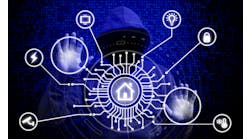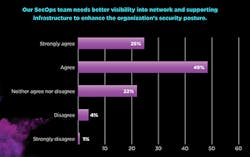Remote Work Propels Network Visibility to Top Concern for Both NetOps and SecOps —
A recent industry study shows that IT teams are asking for better visibility into the network driven by a number of factors, including tremendous disruption from the COVID-19 pandemic, relentless technological advances, remote working reaching an all-time high and the expanding security threatscape. In fact, 73% of survey respondents said security professionals need comprehensive visibility into network infrastructure to enhance cybersecurity efforts and speed remediation.
Results of the survey were compiled from more than 400 respondents, including network engineers, IT directors, security engineers, and CIOs, from around the world. These information security professionals, sometimes called Infosec professionals, use a set strategies for managing the processes, tools and policies necessary to prevent, detect, document and counter threats to digital and non-digital information. These are the survey respondents reporting a rise in cyberthreats. (See Figure 1.)
Figure 1. SD-WAN deployment, application troubleshooting, security monitoring, and remediation, all rely on comprehensive network visibility to be most effective.
More than half of respondents (54%) have already deployed IoT devices. While another 24% of respondents plan to do so in the next 12 months, only 57% of them have a mechanism in place to monitor those devices.
In an age of dynamic disruption, IT is increasingly challenged to maintain optimal service delivery, while implementing remote working at an unprecedented scale. It’s not surprising, then, that nearly 60% of study respondents cite the need for greater visibility into remote user experiences. For the first time in 13 years of the State of the Network study, the top challenge for troubleshooting applications is the ability to understand end-user experience (nearly 47%).
InvisiLight® Solution for Deploying Fiber
April 2, 2022Go to Market Faster. Speed up Network Deployment
April 2, 2022Episode 10: Fiber Optic Closure Specs Explained…
April 1, 2022Food for Thought from Our 2022 ICT Visionaries
April 1, 2022As remote working becomes the new norm, IT teams are challenged to find and adapt technologies, such as flow-based reporting to manage bandwidth consumption, VPN oversubscription, and troubleshooting applications. To guarantee the best performance and reduce cybersecurity threats, increasing network visibility is now a must for all businesses.
Additional survey highlights include:
• Among organizations of all sizes, the most used KPI for assessing end-user experience is packet-based metrics (45%), followed closely by user-satisfaction metrics (41%).
• More than half of survey respondents (54%) have already deployed IoT devices, yet only 57% of those have a mechanism in place to monitor those devices, leaving their networks exposed to vulnerabilities.
• SD-WAN has gone mainstream, with the primary motivations for deployment being cost savings (58%) and business continuity (50%).
Like this Article?
Subscribe to ISE magazine and start receiving your FREE monthly copy today!
Resources and Notes
Source: State of the Network Global Study Methodology
VIAVI (and previously Network Instruments) has conducted its State of the Network global study for 13 consecutive years, drawing insight about network trends and painting a picture of the challenges faced by IT teams. For more information, please visit https://go.viavisolutions.com/viavi-state-of-the-network-2020-disruption










